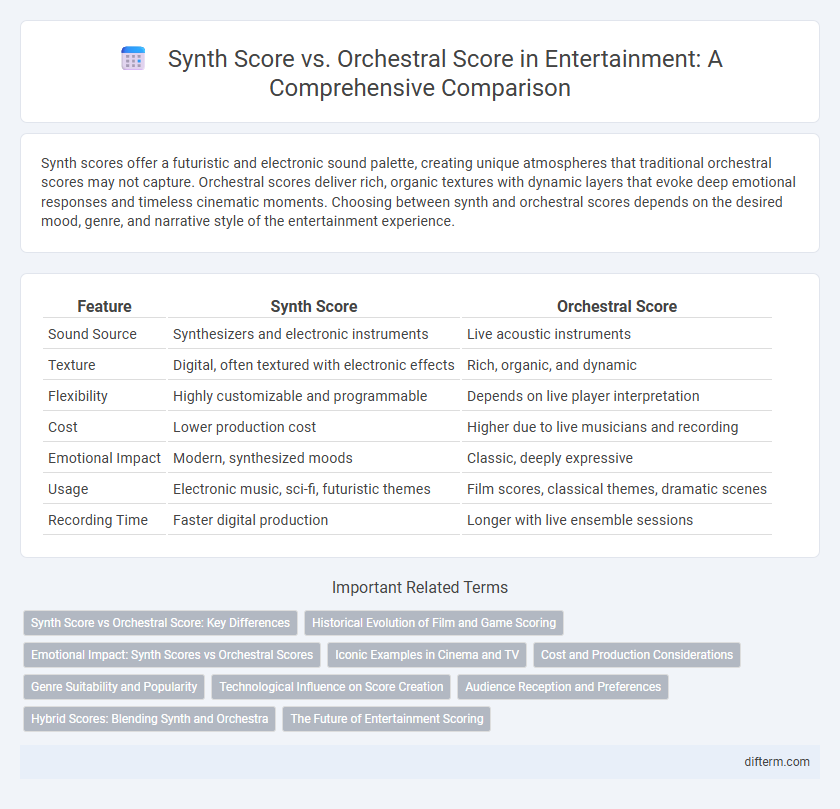Synth scores offer a futuristic and electronic sound palette, creating unique atmospheres that traditional orchestral scores may not capture. Orchestral scores deliver rich, organic textures with dynamic layers that evoke deep emotional responses and timeless cinematic moments. Choosing between synth and orchestral scores depends on the desired mood, genre, and narrative style of the entertainment experience.
Table of Comparison
| Feature | Synth Score | Orchestral Score |
|---|---|---|
| Sound Source | Synthesizers and electronic instruments | Live acoustic instruments |
| Texture | Digital, often textured with electronic effects | Rich, organic, and dynamic |
| Flexibility | Highly customizable and programmable | Depends on live player interpretation |
| Cost | Lower production cost | Higher due to live musicians and recording |
| Emotional Impact | Modern, synthesized moods | Classic, deeply expressive |
| Usage | Electronic music, sci-fi, futuristic themes | Film scores, classical themes, dramatic scenes |
| Recording Time | Faster digital production | Longer with live ensemble sessions |
Synth Score vs Orchestral Score: Key Differences
Synth scores utilize electronic instruments and digital sounds to create futuristic, atmospheric textures, differing significantly from orchestral scores, which rely on traditional acoustic instruments to deliver rich, dynamic, and organic soundscapes. The flexibility of synth scores allows for unconventional sound design and precise control over timbre, whereas orchestral scores emphasize natural instrument blends and expressive crescendos. These fundamental differences shape the emotional impact and genre suitability of soundtracks in film, television, and video games.
Historical Evolution of Film and Game Scoring
Early film and game scores predominantly utilized orchestral compositions, reflecting classical traditions and the limitations of technology during the early 20th century. The advent of synthesizers in the late 1970s and 1980s introduced synthetic scores, allowing composers like Vangelis and Hans Zimmer to craft innovative soundscapes that blended electronic and orchestral elements. This evolution marked a shift in entertainment scoring, where synthetic textures expanded creative possibilities and diversified auditory experiences in both cinematic and interactive media.
Emotional Impact: Synth Scores vs Orchestral Scores
Synth scores evoke a futuristic and atmospheric emotional impact by using electronic textures and rhythmic pulses that create tension and intrigue. Orchestral scores deliver a rich, organic emotional depth through dynamic string, brass, and woodwind arrangements that resonate with human warmth and complexity. The choice between synth and orchestral scoring significantly shapes the audience's emotional experience, with synth often evoking suspense and innovation, while orchestral music tends to elicit nostalgia and grandeur.
Iconic Examples in Cinema and TV
Synth scores like Vangelis' *Blade Runner* create futuristic and atmospheric soundscapes that define sci-fi classics, while orchestral scores such as John Williams' *Star Wars* evoke timeless emotions through rich, dynamic instrumentation. Iconic synth scores bring synthetic textures and pulsating rhythms that enhance cyberpunk and dystopian narratives, contrasting with orchestral scores' sweeping melodies and complex arrangements that support epic storytelling and character development. Films like *Tron* and *Stranger Things* utilize synth-driven music to evoke nostalgia and tension, whereas *Jurassic Park* and *The Crown* rely on orchestral compositions to convey grandeur and emotional depth.
Cost and Production Considerations
Synth scores significantly reduce production costs by eliminating the need for hiring orchestral musicians and renting large recording venues, making them ideal for low-budget projects. Orchestral scores, while more expensive due to live musician fees, conductor salaries, and studio time, offer richer, more dynamic soundscapes preferred in high-end productions. Time efficiency is another factor, as synth scores can be produced quickly with digital tools, whereas orchestral sessions require extensive coordination and rehearsal.
Genre Suitability and Popularity
Synth scores dominate electronic, sci-fi, and cyberpunk genres due to their ability to create futuristic and atmospheric soundscapes, while orchestral scores excel in epic dramas, fantasy, and historical films with rich, emotive compositions. Popularity trends show orchestral scores maintaining a classic appeal and broad audience recognition, whereas synth scores have surged in indie and retro-themed productions for their nostalgic and versatile qualities. Streaming platforms and video game soundtracks increasingly favor synth scores, reflecting growing demand within modern entertainment sectors.
Technological Influence on Score Creation
Technological advancements have revolutionized score creation, with synthetic scores leveraging digital instruments and software for innovative sound design that orchestral scores traditionally rely on live acoustic instrumentation. Synth scores allow composers to experiment with new textures, timbres, and electronic effects, expanding creative possibilities beyond the physical limitations of an orchestra. This shift has enabled faster production cycles and greater accessibility for independent composers in the entertainment industry.
Audience Reception and Preferences
Synth scores often appeal to fans of electronic and contemporary genres due to their innovative sounds and experimental textures, creating a unique auditory experience. Orchestral scores generally resonate more with traditional audiences who appreciate rich, layered instrumentation and emotional depth conveyed through classical arrangements. Audience preferences frequently depend on the film's genre and context, with sci-fi and action movies favoring synth scores, while dramas and period pieces typically employ orchestral compositions to enhance narrative impact.
Hybrid Scores: Blending Synth and Orchestra
Hybrid scores seamlessly integrate synth and orchestral elements to create dynamic soundscapes that enhance storytelling in film and video games. Synth components provide atmospheric textures and futuristic tones, while orchestral layers contribute emotional depth and organic richness. This blend allows composers to craft versatile scores that appeal to both electronic and classical music fans, expanding the expressive range of cinematic music.
The Future of Entertainment Scoring
Synth scores are revolutionizing entertainment scoring by offering versatile sound palettes and cost-effective production compared to traditional orchestral scores. Innovations in AI-driven synthesis and immersive audio technologies increasingly enable composers to create dynamic, customizable soundscapes that enhance storytelling and audience engagement. The future of entertainment scoring lies in hybrid approaches that blend synthesized elements with orchestral textures to deliver emotionally rich and adaptive experiences across films, games, and virtual reality.
Synth score vs Orchestral score Infographic

 difterm.com
difterm.com